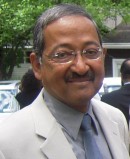

Plenary Lecture
DoS Attack Detection in Internet-Connected Vehicles

Professor Tarek Saadawi
City University of New York
USA
E-mail: saadawi@ccny.cuny.edu
Abstract: The new generations of the Intelligent Transportation Systems depend heavily on communication between vehicles and road-side equipment using IEEE 802.11P and to the Internet via Wi-Fi and cellular technologies. The topic of this presentation is limited to vehicles connected to the Internet via Wi-Fi technology using IEEE 802.11b. The growing list of vehicle manufacturers that include Wi-Fi capabilities to cars to enable the Internet access coupled with the government plans to expand Wi-Fi access to the roads raises the challenges to secure the wireless networks to combat malicious users. In this presentation, we present a method to detect and identify malicious users that attempt to capture the Wi-Fi channel. Malicious user aims to disrupt the communication in the physical range of the hotspot. The disruption of communications can jeopardize the safety of the commuters when real-time applications that require Internet connection, such as road conditions, incidents and traffic updates, are running.
We discuss a light weight technique to detect the Denial of Service (DoS) behavior applied by malicious users in Internet-connected vehicles using Wi-Fi to access the Internet via hotspots installed on the roads. Malicious nodes manipulate the IEEE 802.11 DCF standards to illegally gain extra throughput and increase the probability of having a successful packet transmission on the expense of the honest users that follow the protocol standards. The theoretical network throughput is derived using two-dimensional Markov Chain to determine the network capacity. Results obtained by the theoretical computations are validated by network simulation to determine the baseline for the maximum achievable throughput in the network under fair conditions where all nodes follow the IEEE standards. An approach is presented to enable all the nodes in IEEE 802.11 network with a mechanism to detect and identify the malicious nodes in a distributed environment. Results are presented to prove the effectiveness and feasibility of the proposed algorithm.
Brief Biography of the Speaker: TAREK N. SAADAWI received the B.Sc. and the M.Sc. from Cairo University Egypt in 1973 and 1975 respectively and the Ph.D. from the University of Maryland, College Park in 1980 (all in Electrical Engineering). Since 1980 he has been with the Electrical Engineering Department, The City University of New York, City College where he currently directs the Center of Information Networking and Telecommunications (CINT) and a Professor teaching courses in Network security, computer networks, local area network, communications systems and information theory. His current interests are telecommunications networks security, high-speed networks, multimedia networks, mobile ad-hoc networks and transport layer protocols. He has published extensively in the area of telecommunications networks. He is a co-editor of the book "Cyber Infrastructure Protection," Strategic Study Institute, volume 1, May 2011, and Volume 2 August 2013, and Co-author of the book, Fundamentals of Telecommunication Networks," John Wiley & Sons, 1994 (which has been translated into Chinese) and.
Dr. Saadawi is the co-Chair and co-Organizer of NSF Workshop on Cyber Security, Cairo-Egypt, May 27-30, 2013 and was a Member of the Consortium Management Committee for the Army Research Lab (ARL) Consortium on communications and networks; known as the Collaborative Technology Alliances on Communications and Networks, (1996 – 2011). He is a Senior Member of IEEE, former Technical Editor of IEEE Communications, and former Chairman of IEEE Computer Society of New York City (1986-87). He has received IEEE Region 1 Award, 1987, and the Nippon Telegraph and Telephone (NTT) of America for research on Broadband Telecommunication Networks. Dr Saadawi is a co-founder of IEEE Symposium on Computers and Commuications (ISCC is in its 18th series).
Dr Saadawi and has been invited and joined US Dept of Commerce Delegation to the Government of Algeria to address rural communications. He also led a group of US experts to provide a telecommunications master plan for the Government of Egypt under US AID funding.